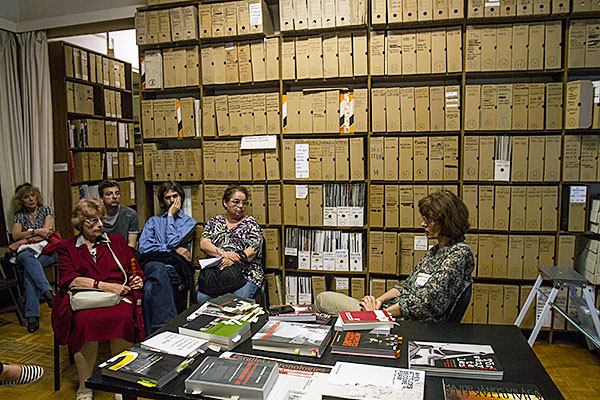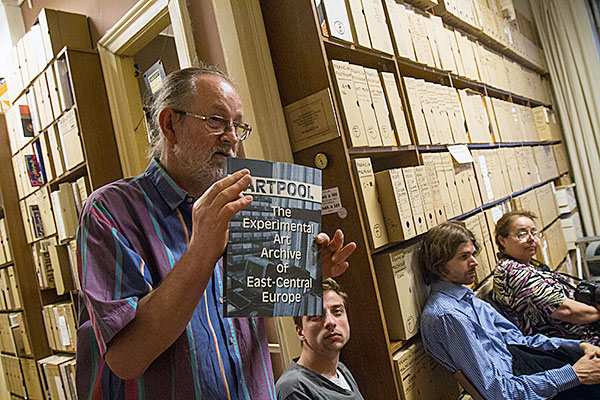2014 - the last year of Artpool - ?? | media feedback
29 May 2014, 10:05, magyarnarancs.hu, Dorka Czenkli
Infected area – Open day in Artpool
Infected area – Open day in Artpool
Artpool is facing the threat of being closed down, so ’while still possible’, an open day was organised, allowing visitors to have a look at the operation of the archive and the treasure it hides. We covered everything from the cellar to the attic, we had a „Happening in the Crypt” and György Galántai was there too.
“Patient people are assisted by chance events,” György Galántai quoted István Eörsi in one of the rooms in Artpool’s cellar, while putting into motion one of his sculptures, which was inspired by Artpool’s activity. “This here is also about chance, and also about will, which all particles, including people, are subjected to…” he is explaining, slightly flustered. All this is fiendishly true for Artpool Art Research Center, which Galántai set up with Júlia Klaniczay in 1979. We have recently written about the institution’s difficult and uncertain situation, which, it seems, has been deteriorating even further. But that will be a different story.
Now let us focus on the open day, organised in three of Artpool’s spaces stretching over 500 square metres. Since the opening of Artpool Archives in 1992 – when the collection was open to all for a whole week – it is the first open day, which makes it a special event. Of course the archive is open to all in general, but during usual research work it is rather unlikely that all the rooms can be visited, the founders will share their personal experiences and stories, and show their works.
“Patient people are assisted by chance events,” György Galántai quoted István Eörsi in one of the rooms in Artpool’s cellar, while putting into motion one of his sculptures, which was inspired by Artpool’s activity. “This here is also about chance, and also about will, which all particles, including people, are subjected to…” he is explaining, slightly flustered. All this is fiendishly true for Artpool Art Research Center, which Galántai set up with Júlia Klaniczay in 1979. We have recently written about the institution’s difficult and uncertain situation, which, it seems, has been deteriorating even further. But that will be a different story.
Now let us focus on the open day, organised in three of Artpool’s spaces stretching over 500 square metres. Since the opening of Artpool Archives in 1992 – when the collection was open to all for a whole week – it is the first open day, which makes it a special event. Of course the archive is open to all in general, but during usual research work it is rather unlikely that all the rooms can be visited, the founders will share their personal experiences and stories, and show their works.

Photo: Dániel Németh
The open day tour started in the research facility on Liszt Ferenc Square, where we could listen to a short summary of the beginnings. Galántai and Klaniczay met in 1976, fell in love, and established Artpool in 1979. First it operated in their own flat, illegally, since it was built on the series of art events that was organised between 1970 and 1973 in Galántai’s banned Balatonboglár Chapel Studio.
“The moment you see life as a battle: you have lost.”
The research area holds literatures from the 1960s onwards both in Hungarian and in foreign languages. The archive mainly has materials on the fine arts with many items about Fluxus, conceptual art, visual and sound poetry as well as Mail Art. The latter occupies an especially important place in the collection since in the 1980s it provided the only means of communication for György Galántai with artists across the world, hence a vast amount of material has been accumulated. One of the drawers in a narrow corridor hides a folder with the material of the 1989 reconstruction of the 1984 exhibition titled Hungary Can Be Yours! The original show was re-staged in 2001, when the relevant documents kept in the historical archive turned up.
The rented property where Artpool can be found was placed at the institution’s disposal by the municipality of Budapest. During our open day tour we also looked at Galántai’s office, which is made interesting by the fact that it is the former venue for the Advisory Office for Fine Arts and was once used by Attila Zsigmond; i.e. ironically, in the past era Zsigmond banned Galántai’s exhibitions while literally sitting in the same place that is now occupied by Galántai’s office.
The Hungarian and foreign archives are separate – or almost separate: the European material is separated from the overseas materials by a door resembling a cabinet door which, like a secret door, leads on to another archive area as large as a flat; the Galántais need to rent this extra space since the original floor space could not hold all the materials.
The documents of Galántai’s oeuvre can also be found behind this deceptive door, and contains the period of the Balatonboglár Chapel Studio, which forms its integral but self-contained part.
The archive consists not only of reference books and documentation but also collections of videos, photographs, audio materials and posters, as well as Fluxus objects, artist’s books and artistamp collections.
“Somebody picked up the tracks behind me, and now here I am alone at the beginning of something new.”
The next station of our tour took us to a cellar used as a storage space located at the other end of Liszt Ferenc Square; it is used for multiples and more bulky artworks. We saw many boxes and folders, i.e. a large amount of unarchived material. “En mass, these are mere deposits, like thick layers of guano,” said Galántai, our guide through the basement area, pulling out a pair of painted patent leather shoes out of nowhere, from among the ’collection of absurd objects’.
“The moment you see life as a battle: you have lost.”
The research area holds literatures from the 1960s onwards both in Hungarian and in foreign languages. The archive mainly has materials on the fine arts with many items about Fluxus, conceptual art, visual and sound poetry as well as Mail Art. The latter occupies an especially important place in the collection since in the 1980s it provided the only means of communication for György Galántai with artists across the world, hence a vast amount of material has been accumulated. One of the drawers in a narrow corridor hides a folder with the material of the 1989 reconstruction of the 1984 exhibition titled Hungary Can Be Yours! The original show was re-staged in 2001, when the relevant documents kept in the historical archive turned up.
The rented property where Artpool can be found was placed at the institution’s disposal by the municipality of Budapest. During our open day tour we also looked at Galántai’s office, which is made interesting by the fact that it is the former venue for the Advisory Office for Fine Arts and was once used by Attila Zsigmond; i.e. ironically, in the past era Zsigmond banned Galántai’s exhibitions while literally sitting in the same place that is now occupied by Galántai’s office.
The Hungarian and foreign archives are separate – or almost separate: the European material is separated from the overseas materials by a door resembling a cabinet door which, like a secret door, leads on to another archive area as large as a flat; the Galántais need to rent this extra space since the original floor space could not hold all the materials.
The documents of Galántai’s oeuvre can also be found behind this deceptive door, and contains the period of the Balatonboglár Chapel Studio, which forms its integral but self-contained part.
The archive consists not only of reference books and documentation but also collections of videos, photographs, audio materials and posters, as well as Fluxus objects, artist’s books and artistamp collections.
“Somebody picked up the tracks behind me, and now here I am alone at the beginning of something new.”
The next station of our tour took us to a cellar used as a storage space located at the other end of Liszt Ferenc Square; it is used for multiples and more bulky artworks. We saw many boxes and folders, i.e. a large amount of unarchived material. “En mass, these are mere deposits, like thick layers of guano,” said Galántai, our guide through the basement area, pulling out a pair of painted patent leather shoes out of nowhere, from among the ’collection of absurd objects’.

Photo: Dániel Németh
Galántai hopes that one day – maybe soon – this collection will become a national treasure. That it will belong not to the state, but to its people. “I think the minimum I can expect is that a formation or system of thought like what we have here – which managed to survive for so long and has come to represent great value – should not perish.”
He then showed us his sculptures inspired by Artpool’s activity, including the one titled World in Motion, illustrating the individual placed at the centre and the movements of the world around him, as well as the Guided Chance peculiarly represented by the opposite movements of two wheels.
At the end of our open day tour, we reached the P60 exhibition space located on Paulay Ede Street, where a sign above the entrance warns those who enter: “Area infected by the culture virus”. The gallery, which was only opened for this special occasion provides a glimpse into the essence of Artpool: it houses all sorts ranging from installations combined with a popular science exhibition featuring the Neo-Avant-garde, super audio effects, bonmots from Ákos Fodor to Duchamp, tricolour wreathe of bulbs, and even some of Galántai’s own pálinka, which we are served in glasses inscribed with a quote by Dixi (János Gémes): “Some are only in it for the booze, but some are only interested in existence.”
Oh, well, existence: it can only be hoped that this was not the last open day on the site of Artpool Archives and the collection will not be closed down.
Dorka Czenkli
(English translation: Krisztina Sarkady-Hart)
He then showed us his sculptures inspired by Artpool’s activity, including the one titled World in Motion, illustrating the individual placed at the centre and the movements of the world around him, as well as the Guided Chance peculiarly represented by the opposite movements of two wheels.
At the end of our open day tour, we reached the P60 exhibition space located on Paulay Ede Street, where a sign above the entrance warns those who enter: “Area infected by the culture virus”. The gallery, which was only opened for this special occasion provides a glimpse into the essence of Artpool: it houses all sorts ranging from installations combined with a popular science exhibition featuring the Neo-Avant-garde, super audio effects, bonmots from Ákos Fodor to Duchamp, tricolour wreathe of bulbs, and even some of Galántai’s own pálinka, which we are served in glasses inscribed with a quote by Dixi (János Gémes): “Some are only in it for the booze, but some are only interested in existence.”
Oh, well, existence: it can only be hoped that this was not the last open day on the site of Artpool Archives and the collection will not be closed down.
Dorka Czenkli
(English translation: Krisztina Sarkady-Hart)
2014 - the last year of Artpool - ?? | media feedback